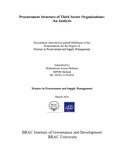| dc.contributor.advisor | Islam, Dr. Md. Zohurul | |
| dc.contributor.author | Rahman, Muhammad Azizur | |
| dc.date.accessioned | 2016-10-04T09:06:35Z | |
| dc.date.available | 2016-10-04T09:06:35Z | |
| dc.date.copyright | 2016 | |
| dc.date.issued | 2016-03 | |
| dc.identifier.other | ID 13382018 | |
| dc.identifier.uri | http://hdl.handle.net/10361/6517 | |
| dc.description | This dissertation is submitted in partial fulfillment of the requirements for the degree of Masters in Procurement and Supply Management, 2016. | en_US |
| dc.description | Cataloged from PDF version of thesis report. | |
| dc.description | Includes bibliographical references (page 98-101). | |
| dc.description.abstract | This thesis has been designed to validate a professional finding for the Third sector while the researcher worked in BRAC as Head of Procurement from 2007 to 2014. The proposal is to carry out an inquisition whether a mixed structure of centralized and decentralized procurement i.e. hybrid structure could be ideal for a large Third sector organization like that of BRAC. In line with this inquiry, the literature review has been carried out first to see what really is meant by the Third Sector. After determining the same, the researcher has delved into the arena of literature review where he has tried to determine which structures are currently being applied and what the current practices of procurement for all three sectors were. Furthermore, the researcher has elaborated various facets of centralized, decentralized and mixed or hybrid procurement structures with specific reference to the Third Sector. In the hybrid segment the four available types, such as Strategically Controlled Action Network (SCAN), Centre Led Action Network (CLAN), Devolved procurement e.g. the Lead Buyer System and Partnering, have also been focused. It is deduced from the review that hybrid structure depending on the type of purchases could be ideal for a large Third Sector Organization like BRAC that is spread over continents.
To further validate the finding, the researcher also carried out surveys though primary data collection. A population of 50 highly qualified procurement professionals was selected from the three sectors for responding to the questionnaire out of which 44 professionals responded. The professionals have the experience of working mostly in the upper level of the procurement function and have risen to their respective positions from the functional level to the strategic level having grasp of the issues involved with designing or streamlining the structure of all three sectors including the Third Sector. As many as 27 questions were framed ranging from the demographic data of the respondents to centralized/decentralized structure and then the hybrid structure. In the survey, Strategically Controlled Action Network (SCAN) hybrid system obtained overwhelming support from 61.4 % respondents, Centre Led Action Network (CLAN) hybrid system got 25 %, the partnering 11.4 % and the Lead Buyer System secured no following. It speaks volumes in support of the thesis that SCAN hybrid system would be ideal for a dispersed organization like BRAC and to a lesser degree CLAN system could be applicable to the Third Sector Organizations where devolvement to the division level is required for meeting the local requirement. | en_US |
| dc.description.statementofresponsibility | Muhammad Azizur Rahman | |
| dc.language.iso | en | en_US |
| dc.publisher | BRAC University | en_US |
| dc.rights | BRAC University dissertation reports are protected by copyright. They may be viewed from this source for any purpose, but reproduction or distribution in any format is prohibited without written permission. | |
| dc.subject | Third sector | en_US |
| dc.subject | Procurement Structure | en_US |
| dc.subject | Matrix organizational structures | en_US |
| dc.title | Procurement structure of third sector organizations: an analysis | en_US |
| dc.type | Thesis | en_US |
| dc.contributor.department | BRAC Institute of Governance and Development | |
| dc.description.degree | M. Procurement and Supply Management | |

